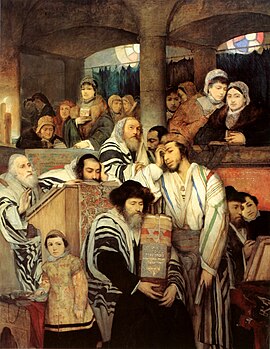Jews Praying in the Synagogue on Yom Kippur
| Jews Praying in the Synagogue on Yom Kippur | |
|---|---|
 | |
| Artist | Maurycy Gottlieb |
| Year | 1878 |
| Medium | Oil on canvas |
| Location | Tel Aviv Museum of Art, Tel Aviv |
Jews Praying in the Synagogue on Yom Kippur was painted by Polish-Jewish artist Maurycy Gottlieb in 1878. It depicts Jews in the midst of the Yom Kippur service, on one of the holiest days of the Jewish calendar.
Yom Kippur is the Jewish holiday of repentance, a time for Jews to repent for their sins and reflect on their behaviour in the past and coming year. As Soussloff writes in Jewish Identity in Modern Art History, "Yom Kippur is also the occasion in the Jewish year when the dead are solemnly commemorated (in the service called Yizkor), and Gottlieb has injected into this picture several prominent self-memorials." In his book Painting a People, Ezra Mendelsohn confirms that Gottlieb’s subject in this painting is the Days of Atonement: "Nathan Samuely, who discussed the work with Gottlieb in 1878, does specifically connect it, in his German essay on the artist published in 1885, with Yom Kippur, and informs us that the artist himself had the idea of painting it during the days of repentance preceding this holiday."
The painting is composed of glazed (semi-transparent) oil paint. Gottlieb used the technique of impasto (wide, three-dimensional brushstrokes), and physically created patterns from the paint. This contributes to the painting's richness and depth.
Content
The figures in the painting appear solemn, and some appear to be in anguish, particularly the central figure (the artist himself), leaning his head on his hand. The adult men are wearing tallitot (ritual garments often referred to in English as prayer shawls) and kippot (head coverings). There is a Torah scroll in the center of the composition, stained glass windows in the back, and candles on the top left. Women look on from the women's balcony; it has been suggested that one of the women is a depiction of Laura Henschel-Rosenfeld, the artist's fiancée.[1]
The artist Maurycy Gottlieb appears in the painting three different times, depicted in different stages of his life. In one self-portrait he is an adult, in another he is a young child, and in the third self-portrait he is depicted as an adolescent. Ezra Mendelsohn writes, "Maurycy himself stands, in a colorful, exotic-looking talith, with head in hand. On the left we have the artist as a small boy, wearing a medallion with his initials written in Hebrew. On the extreme right is a young male figure, perhaps again Maurycy, reading from the prayer book alongside a man who might well be his father. Malinowski assumes that this is the case when he says that the painting presents 'an account of [the artist's] whole life'."
It has been suggested that the artist placed his fiancée Laura among the female worshippers, at the right of the column whispering to another woman (perhaps her mother), and to the left of the column, holding a prayerbook in hand. In the painting, many of the figures are people that are close to Gottlieb or people he knew at the time. As said by the Tel Aviv Museum of Art, Maurycy Gottlieb created this work of art at the young age of 22 years old; a year later, Gottlieb was dead.
Themes and motifs
There are many characteristics that create a somber tone within this painting. Author Jonathan Boyarin described motifs present in the image as “sadness, nostalgia, and beautification. There is no religious ecstasy, no intensity of emotion, only a pervasive melancholy.” The holiday of Yom Kippur is a solemn holiday when it is said that the Book of Life is sealed, and the fates of all those living are decided for the coming year. Certainly this aspect of the occasion would contribute to the sobriety of its depiction.
The somber character of the painting may also reflect the time in which it was painted. During the late 19th century, Jews in what is now Ukraine were living under the auspices of the Russian Empire, in the Pale of Settlement. Antisemitic discrimination was systemic and everpresent, and pogroms and expulsions occurred. Living under this regime in a time of deep antisemitic discrimination and political instability may have had a major impact on Gottlieb's work.
However, the painting may also evoke the anguish Gottlieb experienced in his personal life. Gottlieb may have suffered from depression, and in fact referenced his own suicide in the painting. The mantle of the Torah scroll is inscribed with a Hebrew dedication: "... donated in memory of ... R. Moshe [Maurycy’s Hebrew name] Gottlieb, the righteous of blessed memory."[1] A year after the painting's completion, the aforementioned Laura married another man, breaking her engagement with Gottlieb. He became ill and died shortly thereafter; some believe as a result of physical ailment, but others suspect it was death by suicide due to deep depression.
Notes
- ^ a b "Jews Praying in the Synagogue on Yom Kippur". Tel Aviv Museum of Art. Retrieved 31 May 2018.
External links
- Maurycy Gottlieb, Jews Praying in the Synagogue on Yom Kippur. Tel Aviv Museum of Art, accessed January 31, 2017, http://www.tamuseum.org.il/collection-work/8224.
- Boyarin, Jonathan. "Painting a People: Maurycy Gottlieb and Jewish Art." Slavic Review 2004.
- Gilya and Schmidt. The Art and Artists of the Fifth Zionist Congress, 1901: Heralds of a New Age. Syracuse University Press, 2003.
- Małaszewska, Wanda. "Gottlieb, Maurycy." Grove Art Online, accessed March 19, 2017, http://oxfordindex.oup.com/view/10.1093/gao/9781884446054.article.T033787 Archived 2017-10-20 at the Wayback Machine
- Mendelsohn, Ezra. Painting a People: Maurycy Gottlieb and Jewish Art. Hanover: University Press of New England [for] Brandeis University Press, 2002.
- Rishon, Mekor. "Jews Praying in the Synagogue on Yom Kippur by Maurycy Gottlieb." Accessed January 31, 2017, http://yaelmaly.blogspot.com/2016/10/jews-praying-in-synagogue-on-yom-kippur.html.
- Soussloff, Catherine M. Jewish Identity in Modern Art History. Berkeley [u.a.]: Univ. of California Press, 1999.
